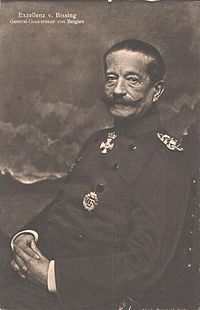- Moritz von Bissing
-
Moritz von Bissing 
Moritz von BissingBorn 30 January 1844
Ober Bellmannsdorf, PrussiaDied 18 April 1917 (aged 73)
Trois Fontaines near Brussels, BelgiumAllegiance  Prussia
Prussia
 Imperial Germany
Imperial GermanyService/branch Prussian Army Years of service 1865-1908
1914-1917Rank General der Kavallerie Commands held VII Army Corps Battles/wars Franco-Prussian War
World War IMoritz Ferdinand Freiherr von Bissing (January 30, 1844 – April 18, 1917) was a Prussian General der Kavallerie.
Early life
Bissing was born at Ober Bellmannsdorf in the Province of Silesia. In 1865 Bissing entered the Prussian Army and raised steadily through the ranks until he became major-general in 1894, lieutenant-general in 1897 and General der Kavallerie. From 1901 to 1907 von Bissing commanded the VII Army Corps in Münster. He retired from the army in 1908.
World War I
Upon the outbreak of the war, von Bissing was recalled to active duty as deputy commander of the VII Army Corps from August 1914 until November 1914. After the fall of Belgium during the First World War, Bissing was promoted to colonel-general and appointed governor-general of occupied Belgium, serving from December 1914 until his death near Brussels. He signed the warrant for the execution of Edith Cavell.
As governor-general von Bissing executed the German Flamenpolitik during which he netherlandized the Ghent University as the first solely Dutch-speaking university. As German Chancellor Bethmann-Hollweg encouraged Flemish nationalist leaders to declare independence and to integrate into the German sphere, Von Bissing convened a commission to organise the division Belgium, and in a decree issed on March 21, 1917, separated Belgium into two administrative areas: Flanders and Wallonia.
Taking into account the 1912 decision by Walloon nationalists to recognize Namur as the most central city of Wallonia, he established the Walloon administration there. Wallonia then consisted of four southern Belgian provinces and one part of the province of Brabant: the district of Nivelles, realizing also another revendication of the Walloon movement: the creation of the Walloon Brabant. The Flemish region had Brussels as its capital, and was made up of the four northern provinces of north, as well as the districts of Brussels and Leuven. This was the first attempt at dividing Belgium along linguistic lines.
He is buried at the Invalidenfriedhof.
Notes
Regarding personal names: Freiherr is a title, translated as Baron, not a first or middle name. The female forms are Freifrau and Freiin.
Categories:- 1844 births
- 1917 deaths
- 19th-century German people
- Cavalry commanders
- German military personnel of World War I
- Prussian generals
- Members of the Prussian House of Lords
- Prussian nobility
- People from the Province of Silesia
- Burials at the Invalid's Cemetery
- European nobility stubs
- German military personnel stubs
Wikimedia Foundation. 2010.
